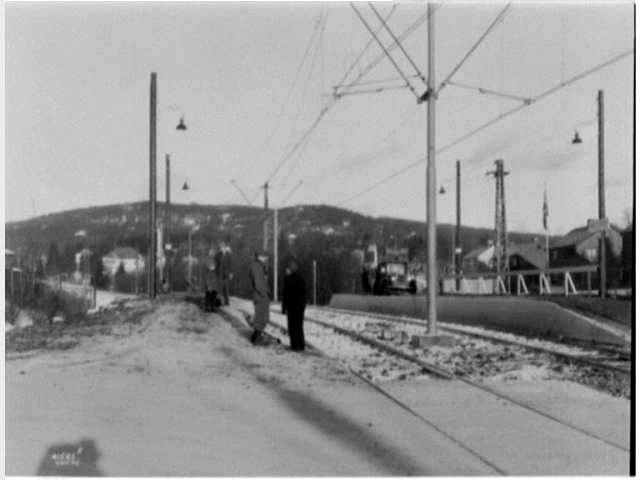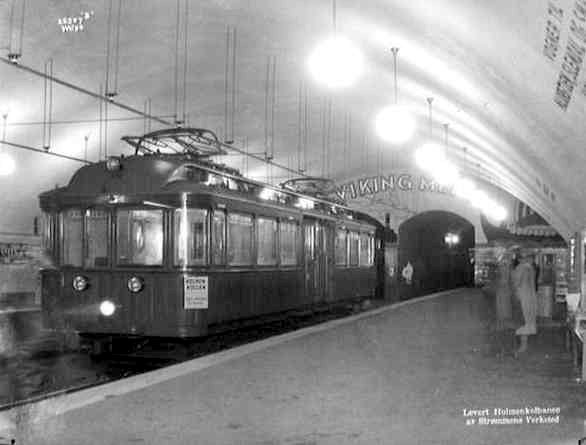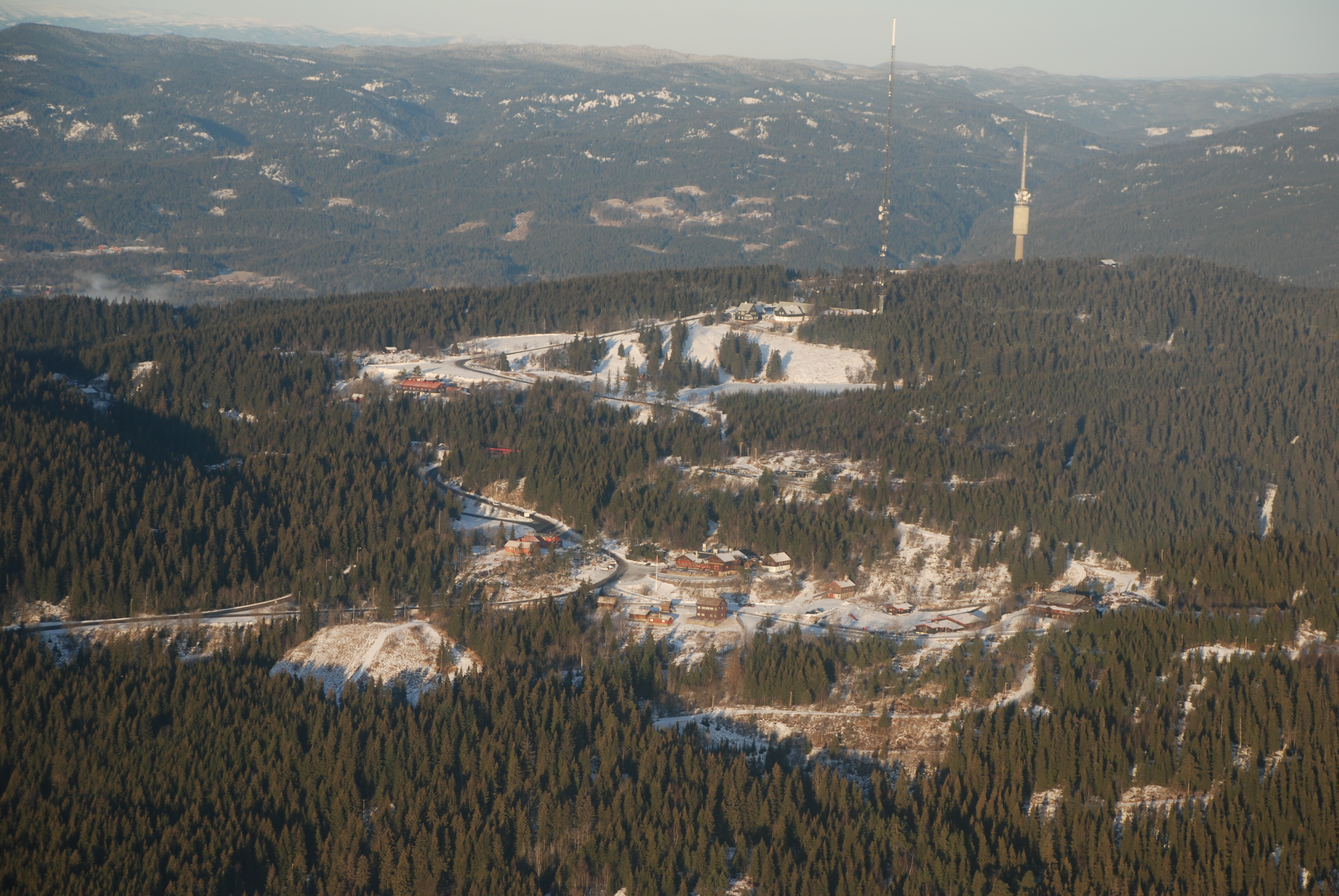|
Holmenkolbanen
A/S Holmenkolbanen was a company that owned and operated part of the Oslo Tramway and Oslo Metro in Norway from 1898 until 1975 when services were taken over by the majority owner Oslo Sporveier. Holmenkolbanen opened the Holmenkoll Line in 1898, and expanded it to become the first Nordic underground railway in 1928. The company took over operations of the Smestad Line in 1933, the Sognsvann Line in 1934. The company was merged into Oslo Sporveier in 1992. History The company was founded on 17 February 1896 by H. M. Heyerdahl and Albert Fenger Krog as the leading executives. The goal was to build a suburban tramway—the Holmenkoll Line—from the Holmenkollen neighborhood in northwestern Oslo to the end of the street tramway at Majorstuen. The line opened first to Besserud (at the time called Holmenkolen) on 31 May 1898 and then to Frognerseteren on 15 May 1916. The second part of the line was constructed by its subsidiary A/S Tryvandsbanen, and included a single track cargo ... [...More Info...] [...Related Items...] OR: [Wikipedia] [Google] [Baidu] |
Common Tunnel
The Common Tunnel ( no, Fellestunnelen), sometimes called the Common Line (), is a long tunnel of the Oslo Metro which runs through the city center of Oslo, Norway. The name derives from the fact that all five lines of the metro use the tunnel, which runs from Majorstuen to Tøyen. The section has six stations, including the four busiest on the metro. The tunnel was first built as two separate tunnels which were later connected. The Holmenkolbanen company opened the western section of the tunnel from Majorstuen via Valkyrie plass to Nationaltheatret in 1928. In 1966, the Oslo Metro opened, including the tunnel from Tøyen via Grønland to Jernbanetorget. In 1977, the eastern end was extended to Sentrum, but the extension was closed in 1983 because of water leakages. In 1987, the Sentrum station reopened as Stortinget, and became the terminus of both the western and eastern lines. By 1993, the western end had been upgraded to metro standard, Valkyrie plass was closed, and the f ... [...More Info...] [...Related Items...] OR: [Wikipedia] [Google] [Baidu] |
Røa Line
The Røa Line ( no, Røabanen) is a rapid transit line of the Oslo Metro, Norway, which runs from Majorstuen in Oslo to Østerås in Bærum. It serves neighborhoods such as Smestad, Hovseter, Huseby and Røa in northwestern Oslo, and Grini, Øvrevoll and Østerås in northeastern Bærum. The line is served by Line 2 of the metro, which connects to the city center via the Common Tunnel and onwards along the Furuset Line. The lowest part of the Røa Line, consisting of two stations, is shared with the Kolsås Line, and thus also served by Line 2 of the metro. The Røa Line is owned by Kollektivtransportproduksjon, and operated by Oslo T-banedrift on contract with the public transport agency Ruter. The first part of the line, originally a light rail, was from Majorstuen to Smestad, and opened in 1912. It was built as a cooperation between the Municipality of Aker and the company Holmenkolbanen, and connected to the Holmenkoll Line's terminus. In 1928, the line received a conn ... [...More Info...] [...Related Items...] OR: [Wikipedia] [Google] [Baidu] |
Nationaltheatret (station)
Nationaltheatret is an underground metro station and tram stop serving Vika and the city center of Oslo, Norway. It is located on the Common Tunnel of the Oslo Metro and on the Briskeby Line of the Oslo Tramway. Also located at the same place is Nationaltheatret Station of the Drammen Line. The station is served by all five lines of the metro, and lines 11 and 13 of the tramway. In addition, several bus services call at the station. It is named for the National Theatre located nearby. The tram stop in the area opened in 1894. Nationaltheatret was the first underground station in the Nordic countries; construction of a tunnel from Majorstuen to the city center started in 1912, but was not finished until 1928. Until the 1987 opening of Stortinget, Nationaltheatret was the city terminus for the four western light rail lines: the Holmenkollen Line, the Røa Line, the Sognsvann Line (from 1934) and the Kjelsås Line (from 1942). The mainline railway station opened in 1980, and ... [...More Info...] [...Related Items...] OR: [Wikipedia] [Google] [Baidu] |
Holmenkoll Line
The Holmenkollen Line ( no, Holmenkollbanen) is an Oslo Metro line which runs between Majorstuen and Nordmarka in Oslo, Norway. Operating as Metro Line 1, it is the route with the fewest passengers and the only one still to have level crossings and short station platforms. The line runs mostly through residential areas of detached houses, and the upper parts of the line principally serve the recreational area of Nordmarka. Holmenkollen Station is located close to Holmenkollen National Arena which hosts international Nordic skiing tournaments. Voksenkollen Station is not far from Oslo Vinterpark (Winter) and the Oslo Sommerpark (Summer). The line is the oldest one on the metro system, having been opened as a light railway in 1898 by the Holmenkolbanen company. Originally it ran for from Majorstuen Station to Besserud. In 1916, the line was extended to Tryvann, with the last being used for freight only. In 1928, the city terminus was moved to the underground Nationaltheatret ... [...More Info...] [...Related Items...] OR: [Wikipedia] [Google] [Baidu] |
Oslo Sporveier
AS Oslo Sporveier is a defunct municipal owned company responsible for public transport in Oslo, Norway. It was created in 1924 to take over the city's two private tram companies. In 1927 its started with bus transport, including from 1940 to 1968 trolleybuses. Since 1966 rapid transit and from 1985 water buses have also been operated by the company. It was split into two separate companies in 2006; Kollektivtransportproduksjon took over the operation while Oslo Public Transport Administration (who retained the Oslo Sporveier brand) was responsible for buying the services, fare regulation and marketing. The latter merged into Ruter in 2008, when the Oslo Sporveier brand was discontinued. History It all started with trams In 1875, Kristiania Sporveisselskab (KSS) started the first horsecar services in Oslo—at the time called Kristiania. It was followed by Kristiania Elektriske Sporvei (KES) who established electric tram services in 1894; by 1900 KSS had also converted its route ... [...More Info...] [...Related Items...] OR: [Wikipedia] [Google] [Baidu] |
Akersbanerne
A/S Akersbanerne was a municipal owned company that operated tramways in the former Municipality of Aker in current Oslo, Norway. The company was established in 1917, and opened the suburban Østensjø Line tramway in 1926; it took over the majority ownership of Holmenkolbanen in 1933, that owned the Holmenkoll Line, Sognsvann Line and the Røa Line. Akersbanerne merged with Oslo Sporveier in 1949, following the merger of the municipalities. History The company was founded on 7 June 1917 to coordinate the construction of new suburban tramways from Kristiania (now Oslo) to the new suburbs in Aker. The company planned to build several lines from the end of the street tramways in the city, and extend them on grade-separated right-of-way. The first project was the Østensjø Line; with construction starting in 1922 it opened from Vålerenga to Bryn on 18 December 1923 and to Oppsal on 10 January 1926. For the first three years street trams operated by Kristiania Sporveisselskab w ... [...More Info...] [...Related Items...] OR: [Wikipedia] [Google] [Baidu] |
Kolsås Line
The Kolsås Line ( no, Kolsåsbanen) is a line of the Oslo Metro. It branches off from the Røa Line at Smestad Station and runs through western Oslo and Bærum to Kolsås Station. It serves the neighborhoods of Ullernåsen, Øraker, Jar, Bekkestua, Haslum, Gjettum and Kolsås. It is served by Line 3 of the metro at a 15-minute headway. The section from Jar to Bekkestua is built as a dual system with overhead wires, allowing Line 13 of the Oslo Tramway to continue from the Lilleaker Line to Bekkestua every ten minutes. The Kolsås Line was built as an extension of the Lilleaker Line. It had been built to Lilleaker in 1919. The line was extended to Avløs on 1 July 1924, and the line was extended to Kolsås on 1 January 1930. The line was initially owned by Bærumsbanen, which was bought by Oslo Sporveier in 1934. A connection to the Røa Line opened on 15 June 1942, allowing the line access to the Common Tunnel. At this point the section from Sørbyhaugen to Kolsås was ... [...More Info...] [...Related Items...] OR: [Wikipedia] [Google] [Baidu] |
Oslo Metro
The Oslo Metro ( no, Oslo T-bane or or simply ) is the rapid transit system of Oslo, Norway, operated by Sporveien T-banen on contract from the transit authority Ruter. The network consists of five lines that all run through the city centre, with a total length of , serving 101 stations of which 17 are underground or indoors. In addition to serving 14 out of the 15 boroughs of Oslo, two lines run to Kolsås and Østerås, in the neighboring municipality of Bærum. In 2016, the system had an annual ridership of 118 million. The first rapid transit line, the Holmenkollen Line, opened in 1898, with the branch Røa Line opening in 1912. It became the first Nordic underground rapid transit system in 1928, when the underground line to Nationaltheatret was opened. After 1993 trains ran under the city between the eastern and western networks in the Common Tunnel, followed by the 2006 opening of the Ring Line. All the trains are operated with MX3000 stock. These replaced the older T100 ... [...More Info...] [...Related Items...] OR: [Wikipedia] [Google] [Baidu] |
Tryvandshøiden (station)
Tryvandshøiden (also Tryvannshøgda, Tryvann and Øvreseter) was a planned station on the Holmenkollen Line in Oslo, Norway. It was planned by the company Tryvandsbanen in the early 1910s and partly constructed in 1916 at the end of a single-tracked line from Frognerseteren. A red signalman's house named "Norden" was the station's only facility. Passenger trains never served the station, and the tracks from Frognerseteren to Tryvandshøiden were removed in 1939. The signalman's house was not demolished. In 1993, 2004 and 2008, proposals were made to re-open the station so that it would be more convenient for Oslo residents to use the Tryvann Ski Resort. However, these proposals were all rejected by the operator Oslo Sporveier on the grounds that the extension would be too expensive. History In 1898, Holmenkolbanen opened the Holmenkollen Line from Majorstuen to Besserud station (then Holmenkollen). In 1910–11, a recently established company named Tryvandsbanen planned to e ... [...More Info...] [...Related Items...] OR: [Wikipedia] [Google] [Baidu] |
A/S Tryvandsbanen
A/S Tryvandsbanen was a Norwegian company that constructed a rail extension nicknamed Tryvandsbanen ("Tryvann Line") of the Holmenkoll Line The Holmenkollen Line ( no, Holmenkollbanen) is an Oslo Metro line which runs between Majorstuen and Nordmarka in Oslo, Norway. Operating as Metro Line 1, it is the route with the fewest passengers and the only one still to have level crossings ... from Besserud (then Holmenkollen) to Tryvandshøiden station. The company was established 4 January 1912 and opened the Tryvann Line 15 May 1916. Tryvandsbanen was disestablished on 1 January 1920. References 1911 establishments in Norway 1920 disestablishments in Norway Norwegian companies established in 1911 Railway companies established in 1911 Railway companies disestablished in 1920 {{oslo-metro-stub ... [...More Info...] [...Related Items...] OR: [Wikipedia] [Google] [Baidu] |
Norway
Norway, officially the Kingdom of Norway, is a Nordic country in Northern Europe, the mainland territory of which comprises the western and northernmost portion of the Scandinavian Peninsula. The remote Arctic island of Jan Mayen and the archipelago of Svalbard also form part of Norway. Bouvet Island, located in the Subantarctic, is a dependency of Norway; it also lays claims to the Antarctic territories of Peter I Island and Queen Maud Land. The capital and largest city in Norway is Oslo. Norway has a total area of and had a population of 5,425,270 in January 2022. The country shares a long eastern border with Sweden at a length of . It is bordered by Finland and Russia to the northeast and the Skagerrak strait to the south, on the other side of which are Denmark and the United Kingdom. Norway has an extensive coastline, facing the North Atlantic Ocean and the Barents Sea. The maritime influence dominates Norway's climate, with mild lowland temperatures on the se ... [...More Info...] [...Related Items...] OR: [Wikipedia] [Google] [Baidu] |



